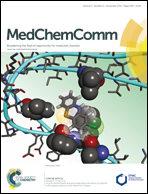A synthesis, in silico, in vitro and in vivo study of thieno[2,3-b]pyridine anticancer analogues†
Abstract
The anticancer activity of the thieno[2,3-b]pyridines was explored by altering the ring size of the cyclo-aliphatic moiety. Five-, six-, seven- and eight-membered derivatives were tested against the NCI60 tumour cell panel. According to this assay the most active derivative 9a has a cyclooctane moiety, which suggests that larger aliphatic ring systems are favourable. For the most sensitive tumour cell line MB-MDA-435, derivative 9a has a GI50 = 70 nM and a LC50 = 925 nM. To explore the biological mechanism of the thieno[2,3-b]pyridines five derivatives were tested against tyrosyl-DNA phosphodiesterase I (TDP1), a phospholipase D enzyme, using a biochemical assay. The most potent derivative for TDP1 was 9d, giving an excellent IC50 at 0.5 ± 0.1 μM. Also, derivative 12 was tested against 97 kinases and no or very limited activity was found, excluding this class of biomolecular targets. Finally, a mouse xenograft study using derivative 12 was encouraging but the tumour size/mass reduction was not quite statistically significant.
![Graphical abstract: A synthesis, in silico, in vitro and in vivo study of thieno[2,3-b]pyridine anticancer analogues](/en/Image/Get?imageInfo.ImageType=GA&imageInfo.ImageIdentifier.ManuscriptID=C5MD00245A&imageInfo.ImageIdentifier.Year=2015)

 Please wait while we load your content...
Please wait while we load your content...